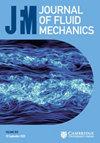壁挂式圆筒角膜的脱水处理
IF 3.9
2区 工程技术
Q1 MECHANICS
引用次数: 0
摘要
在本研究中,我们采用理论和数值相结合的方法,研究了附着在圆柱体和基体之间转角处的薄膜的稳定性。值得注意的是,我们将重点放在平薄薄膜上,即接触线几乎垂直于圆筒壁,而接触线与基底之间形成一个小角度,薄膜尺寸小于圆筒半径。薄膜稳定性取决于薄膜尺寸和壁面润湿性,我们首先在长波理论框架内通过标准线性稳定性分析 (LSA) 预测了薄膜稳定性。我们发现,薄膜尺寸在控制薄膜稳定性方面发挥着最重要的作用。具体来说,薄膜越厚,对大波长扰动的敏感性就越低。膜壁润湿性主要影响扰动的增长速度,对缠绕薄膜的边际稳定性和后不稳定性模式影响较小。我们将 LSA 预测结果与分离压力模型(DPM)和流体容积(VOF)模拟得出的数值结果进行了比较,从而对薄膜破裂过程有了更深入的了解。在早期阶段,LSA 预测结果与 DPM 结果非常一致。值得注意的是,随着扰动的增加,会形成连接两个相邻卫星液滴的薄膜区域,最终可能形成稳定或暂时的次级液滴,而 LSA 无法捕捉到这一点。此外,VOF 模拟表明,在超过临界薄膜尺寸后,两个相邻液滴之间的合并会在破裂阶段发生。因此,LSA 预测只能提供卫星液滴最终数量的上限。本文章由计算机程序翻译,如有差异,请以英文原文为准。
Dewetting of a corner film wrapping a wall-mounted cylinder
In this study, we investigate the stability of a film that is attached to a corner between a cylinder and a substrate, using a combination of theoretical and numerical approaches. Notably, we place our focus on flat and thin films where the contact line is almost perpendicular to the cylinder wall whereas a small angle forms between the contact line and the substrate, and the film size is smaller than the cylinder radius. The film stability, which depends on the film size and the wall wettability, is first predicted by a standard linear stability analysis (LSA) within the long-wave theoretical framework. We find that the film size plays the most important role in controlling the film stability. Specifically, the thicker the film is, the less sensitive it becomes to the large-wavenumber perturbation. The wall wettability mainly impacts the growth rates of perturbations and slightly influences the marginal stability and postinstability patterns of wrapping films. We compare the LSA predictions with numerical results obtained from a disjoining pressure model (DPM) and volume-of-fluid (VOF) simulations, which provide more insights into the film breakup process. At the early stage there is a strong agreement between the LSA predictions and the DPM results. Notably, as the perturbation grows, thin film regions connecting two neighbouring satellite droplets form which may eventually lead to a stable or temporary secondary droplet, an aspect which the LSA is incapable of capturing. In addition, the VOF simulations suggest that beyond a critical film size, merging between two neighbouring drops becomes involved during the breakup stage. Therefore, the LSA predictions are able to provide only an upper limit on the final number of satellite droplets.
求助全文
通过发布文献求助,成功后即可免费获取论文全文。
去求助
来源期刊
CiteScore
6.50
自引率
27.00%
发文量
945
审稿时长
5.1 months
期刊介绍:
Journal of Fluid Mechanics is the leading international journal in the field and is essential reading for all those concerned with developments in fluid mechanics. It publishes authoritative articles covering theoretical, computational and experimental investigations of all aspects of the mechanics of fluids. Each issue contains papers on both the fundamental aspects of fluid mechanics, and their applications to other fields such as aeronautics, astrophysics, biology, chemical and mechanical engineering, hydraulics, meteorology, oceanography, geology, acoustics and combustion.

 求助内容:
求助内容: 应助结果提醒方式:
应助结果提醒方式:


